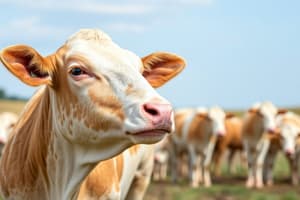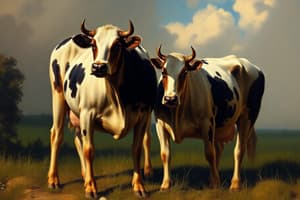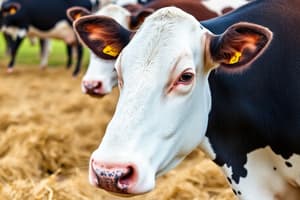Podcast
Questions and Answers
Which of the following best describes the primary role of carbohydrates in animal nutrition?
Which of the following best describes the primary role of carbohydrates in animal nutrition?
- Primary source of energy (correct)
- Building blocks for tissues and enzymes
- Essential components for bone formation
- Facilitating metabolic processes
Crude protein (CP) content alone is sufficient to determine the quality of protein for animal nutrition.
Crude protein (CP) content alone is sufficient to determine the quality of protein for animal nutrition.
False (B)
What is the primary function of the rumen in ruminant animals, and why is it significant?
What is the primary function of the rumen in ruminant animals, and why is it significant?
The rumen is a fermentation vat where microorganisms break down fiber and other complex carbohydrates, which allows ruminants to efficiently utilize fibrous feedstuffs that monogastric animals cannot digest.
________ is a digestive disorder in ruminants caused by rapid fermentation of carbohydrates, leading to a drop in rumen pH.
________ is a digestive disorder in ruminants caused by rapid fermentation of carbohydrates, leading to a drop in rumen pH.
Match the following feedstuffs with their primary characteristic:
Match the following feedstuffs with their primary characteristic:
Which of the following is a key consideration in sustainable animal nutrition?
Which of the following is a key consideration in sustainable animal nutrition?
Monogastric animals, such as cattle, have a complex, four-compartment stomach similar to ruminant animals.
Monogastric animals, such as cattle, have a complex, four-compartment stomach similar to ruminant animals.
In feed formulation, what mathematical technique is used to optimizes feed formulation by considering nutrient constraints and ingredient costs?
In feed formulation, what mathematical technique is used to optimizes feed formulation by considering nutrient constraints and ingredient costs?
________ are beneficial bacteria that can improve gut health and nutrient absorption in animals, often used as feed additives.
________ are beneficial bacteria that can improve gut health and nutrient absorption in animals, often used as feed additives.
Which vitamin is crucial for calcium absorption?
Which vitamin is crucial for calcium absorption?
Flashcards
Animal Nutrition
Animal Nutrition
Study of nutritional needs of domestic animals for efficient and sustainable production.
Nutrients
Nutrients
Substances providing nourishment essential for growth and life maintenance.
Carbohydrates
Carbohydrates
Animal's primary energy source, mainly from plant-based feeds.
Proteins
Proteins
Signup and view all the flashcards
Energy Requirements
Energy Requirements
Signup and view all the flashcards
Feedstuffs
Feedstuffs
Signup and view all the flashcards
Roughages
Roughages
Signup and view all the flashcards
Concentrates
Concentrates
Signup and view all the flashcards
Feed Formulation
Feed Formulation
Signup and view all the flashcards
Sustainable Animal Nutrition
Sustainable Animal Nutrition
Signup and view all the flashcards
Study Notes
- Animal nutrition focuses on the nutritional needs of domestic animals
- Animal nutrition aims for efficient and sustainable production of animal-derived foods
- It requires understanding of nutrient requirements, feed formulation
- Animal nutrition impacts animal health, productivity, and product quality
Basic Concepts
- Nutrients provide nourishment essential for growth and the maintenance of life
- Key nutrient categories: carbohydrates, proteins, lipids, vitamins, minerals, and water
- Carbohydrates: primary energy source for animals, mainly from plant-based feeds
- Proteins supply amino acids, which are the building blocks for tissues, enzymes, hormones, and other vital compounds
- Lipids (fats and oils): concentrated energy sources, provide essential fatty acids
- Vitamins are organic compounds required in small amounts for various metabolic processes
- Minerals: inorganic substances needed for bone formation, enzyme function, and maintaining electrolyte balance
- Water: essential for bodily functions, including nutrient transport, temperature regulation, and waste excretion
Nutrient Requirements
- Nutrient requirements vary depending on the animal species, age, physiological state (growth, pregnancy, lactation), and level of activity
- Energy requirements are typically expressed as digestible energy (DE), metabolizable energy (ME), or net energy (NE)
- Protein requirements are often expressed in terms of crude protein (CP), but the quality of protein depends on its amino acid composition
- Essential amino acids: those that cannot be synthesized by the animal and must be supplied in the diet
- Mineral requirements are critical for skeletal development, enzyme function, and overall health
- Calcium and phosphorus are essential for bone formation
- Trace minerals like zinc, copper, and selenium play vital roles in enzyme systems
- Vitamin requirements are relatively small but crucial for specific metabolic pathways
- Vitamin A is important for vision, reproduction, and immune function
- Vitamin D is essential for calcium absorption
- Water requirements depend on environmental temperature, activity level, and physiological state
Feedstuffs
- Feedstuffs are materials used as food for animals, providing the necessary nutrients to meet their requirements
- Roughages are high-fiber feedstuffs such as pasture, hay, silage, and straw
- Concentrates are low-fiber, high-energy feedstuffs like grains (corn, barley, oats), oilseeds (soybeans, canola), and byproduct feeds (wheat bran, distillers grains)
- Pasture is fresh forage consumed directly by grazing animals
- Pasture can be a cost-effective feed source
- Hay is dried forage preserved for later use
- Hay quality depends on the stage of maturity at harvest and curing conditions
- Silage is fermented forage stored under anaerobic conditions
- Silage preserves nutrients and provides a palatable feed
- Grains are energy-rich concentrates that provide carbohydrates and some protein
- Oilseeds are high in protein and fat
- Oilseeds are valuable supplements for improving the energy and protein content of diets
- Byproduct feeds are derived from processing agricultural products
- Byproduct feeds can be cost-effective sources of nutrients
Feed Formulation
- Feed formulation involves combining different feedstuffs to create a balanced diet that meets the animal's nutrient requirements
- The process involves determining the animal's nutrient requirements, analyzing the nutrient content of available feedstuffs
- Feed formulation uses software or calculations to determine the optimal mix
- Least-cost formulation is a common approach that aims to minimize feed costs while meeting nutrient requirements
- Linear programming is a mathematical technique used to optimize feed formulation by considering nutrient constraints and ingredient costs
- Ration balancing ensures that the diet provides the correct proportions of energy, protein, vitamins, and minerals
- Feed additives are substances added to the diet to improve animal performance, health, or product quality
- Antibiotics were historically used as growth promoters but are now regulated due to concerns about antimicrobial resistance
- Probiotics are beneficial bacteria that can improve gut health and nutrient absorption
- Enzymes can enhance the digestibility of certain feed components, such as fiber or phytate
- Mycotoxin binders can reduce the negative effects of mycotoxins, which are toxic compounds produced by molds in feed
Digestive Systems
- Monogastric animals (pigs, poultry) have a simple stomach
- Monogastric animals rely on enzymes secreted by the animal to digest feed
- Ruminant animals (cattle, sheep, goats) have a complex, four-compartment stomach (rumen, reticulum, omasum, abomasum)
- The rumen is a large fermentation vat where microorganisms break down fiber and other complex carbohydrates
- Ruminants can utilize fibrous feedstuffs that monogastric animals cannot digest efficiently
- The abomasum is the true stomach of the ruminant, where gastric digestion occurs
- Avian species have a unique digestive system with a crop for feed storage, a proventriculus for gastric digestion, and a gizzard for mechanical grinding of feed
Nutritional Disorders
- Nutritional disorders can arise from nutrient deficiencies, excesses, or imbalances in the diet
- Vitamin and mineral deficiencies can lead to specific health problems, such as rickets (vitamin D deficiency) or white muscle disease (selenium deficiency)
- Energy imbalances can result in obesity or emaciation, affecting reproductive performance and overall health
- Metabolic disorders, such as milk fever (calcium deficiency) in dairy cows or ketosis (energy deficiency) in ruminants, can occur during periods of high nutrient demand
- Acidosis is a digestive disorder in ruminants caused by rapid fermentation of carbohydrates, leading to a drop in rumen pH
- Bloat is a condition in ruminants where gas accumulates in the rumen, causing distension and potential suffocation
Impact on Animal Health and Productivity
- Proper nutrition is essential for maintaining animal health, supporting growth and reproduction, and maximizing productivity
- Balanced diets can improve immune function and reduce the incidence of disease
- Adequate nutrient intake is critical for growth and development, particularly during early life stages
- Reproductive performance is highly influenced by nutrition
- Nutrient deficiencies or imbalances lead to reduced fertility and increased embryonic mortality
- Milk production in dairy cows is directly related to nutrient intake, particularly energy and protein
- Meat quality can be influenced by nutrition, with dietary fat affecting carcass composition and fatty acid profile
- Fiber digestion in the rumen is complex and involves a symbiotic relationship between the animal and microorganisms
- Volatile fatty acids (VFAs) are produced during fiber fermentation and serve as the primary energy source for ruminants
Sustainable Animal Nutrition
- Sustainable animal nutrition focuses on optimizing nutrient utilization, reducing waste, and minimizing environmental impact
- Precision feeding involves tailoring nutrient supply to meet the specific needs of individual animals or groups, reducing nutrient excretion
- Improving feed efficiency, which is the amount of feed required to produce a unit of animal product lowers feed costs
- Utilizing alternative feedstuffs, such as byproduct feeds or novel protein sources, can reduce reliance on traditional feed ingredients
- Reducing nitrogen and phosphorus excretion from animal production systems can minimize water and air pollution
- Phytase supplementation can improve phosphorus utilization and reduce phosphorus excretion in monogastric animals
- Manure management practices, such as composting or anaerobic digestion, can convert manure into valuable fertilizer or energy sources
Advances in Animal Nutrition
- Advances in animal nutrition include the use of genomics, proteomics, and metabolomics to better understand nutrient metabolism and individual animal responses
- Nutrigenomics studies the interaction between nutrients and gene expression
- Nutrigenomics provides insights into how diet affects animal health and performance at the molecular level
- Precision livestock farming utilizes sensors and data analytics to monitor animal behavior, health, and nutrient intake in real-time
- Precision livestock farming enables more precise management decisions
- The development of novel feed additives, such as probiotics, prebiotics, and enzymes, continues to improve animal health and nutrient utilization
- Research on gut microbiome manipulation aims to enhance digestive efficiency and immune function by altering the composition of gut bacteria
- CRISPR-Cas9 gene editing technology is being explored to improve animal traits related to nutrition, such as disease resistance and feed efficiency
Studying That Suits You
Use AI to generate personalized quizzes and flashcards to suit your learning preferences.




